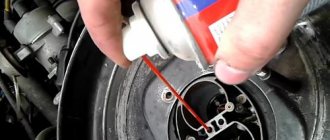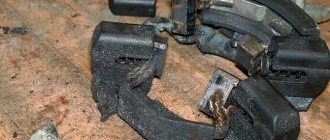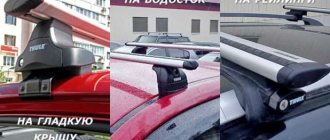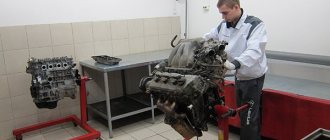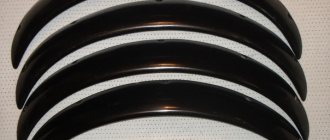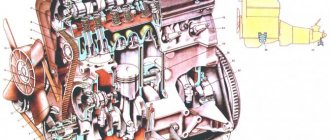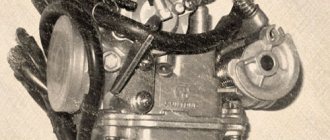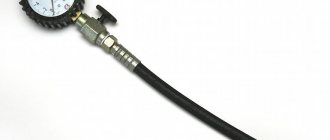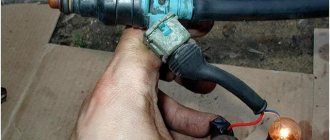The secret of 99 - how is people's love justified?
The car, whose history goes back almost four decades, is still considered one of the most successful VAZ assemblies. Until 2004, all VAZ 21099 models had a carburetor engine type, and only after 2004 did manufacturers replace this device with an injector. So the carburetor 99, a symbol of the dashing 90s, is today found on the roads of post-Soviet countries no less often than modern cars.
The car has front-wheel drive, a 1.5 liter 4-cylinder engine. A VAZ car can accelerate to 160 km/h with its 70 hp. Some models have a 1.5i engine with 76 hp, although not many of these cars were produced. The carburetor of model 21099 is very economical, the average consumption of the VAZ 21099 reaches 7–7.5 l/100 km. Fuel consumption on the highway with high-quality fuel and average speed is 5.5 liters.
conclusions
The fuel system check valve is an important component of this system, the failure of which can cause a lot of problems for the driver. This will be especially painful during movement. Therefore, it is worth using only high-quality fuel, and at the slightest sign of a malfunction, which were listed above, diagnosing the fuel system.
After all, the problem may lie not only in the valve, but also in other small parts. Diagnostics at a service station almost always reveals such faults, so do not forget about timely maintenance of the car, even if everything seems to be in good order.
Carburetor design - what's inside?
The VAZ 21099 carburetor is technically very well made and is not picky about fuel quality. The device consists of 2 chambers in which fuel is distributed and further injected into the car engine. The operation of the first chamber of the carburetor ensures a smooth transition from idle to throttling mode. The main process of supplying the fuel mixture occurs in the second chamber of the device. The fuel in the chamber rises up through the tubes and mixes with air.
The main action in the operation of the second chamber is performed by the econostat - when the throttle valves are open while driving at high speed, it enriches the fuel mixture. The starting device is responsible for preparing a saturated combustible mixture when starting a cold engine. The air damper in this device is offset and opens with a flow of air, as a result of which it retracts the throttle spring and ensures uniform mixing of the mixture.
A device called an economizer is responsible for idling in the VAZ 21099 carburetor. It consists of a switch mounted on an adjusting screw, an electromagnetic valve, a control unit and a switch. The economizer shuts down during forced idle, during sudden braking of the car engine, when changing gears and while the engine is running on an incline.
This device is very useful as it prevents the release of carbon monoxide into the atmosphere. When operating at forced idle, the engine speed increases and can reach 2100 rpm. In this case, the solenoid valve is activated, which acts on the power control unit and turns it off - the fuel supply in the idle system is stopped.
Check valve functions
The fuel pumps of modern cars have high performance and, with proper care, provide a continuous supply of fuel, regardless of the load being generated. It is impossible for the engine to operate at idle speed without a fuel system check valve.
Moreover, this unit is present not only in gasoline engines with a carburetor and in injection engines. The check valve for the fuel system of a diesel engine is also an indispensable part of the fuel system of such engines.
The main purpose of this valve is to prevent the build-up of too high pressure in the fuel system, which could result in the fuel hoses breaking. In principle, the purpose of any valve is to allow the movement of different fluids in one main direction. Located in the fuel system, this valve prevents a number of problems that can arise in the system as a result of broken hoses.
For example, if you are driving a car with a diesel engine, then a breakdown of the check valve along the way can cause the fuel system to begin to fill with air.
If the driver stops the engine, while fuel flows into the tank along the working line, then the vacated space is quickly filled with air. In such situations, you will have to turn the engine with the starter for at least fifty seconds.
Causes of failure - we make a diagnosis
Very often, owners of 99 VAZ are faced with the problem of poor engine performance, which can occur in both warm and cold seasons. One of the main reasons for this problem is malfunctions of the carburetor. The symptoms that arise during malfunctions are very easy to notice - the car does not start well, the speed on the tachometer fluctuates, unusual sounds in the form of pops can be heard from the exhaust pipe.
While driving, the VAZ 21099 may stall when changing gears. During acceleration or releasing the gas pedal, jerking and failures in operation are possible. Fuel consumption increases noticeably.
If you find problems with the operation of the VAZ 21099 carburetor, then in case of minor damage it can be repaired or replaced with a new one, if the problems are more serious. Repairing a carburetor is a delicate matter and requires experience in the work. For self-repair, you will need a standard set of tools and, preferably, a book on the maintenance and repair of this type of device.
Made in USSR: Fuel check valve VAZ-2108. Lifehack
I wouldn't be posting this about my minor Ruby renovation if I hadn't encountered a lot of inconsistency online. It all started with the fact that my fuel return hose became leaky due to old age. When I started replacing it with a new one, having previously cut the necessary scraps, I noticed my fuel return valve, made back in the USSR.
I decided to google it, and then the shock came! I am surprised by people who make mistakes themselves, and at the same time, with full responsibility, give advice to beginners online. Therefore, in order, I’ll lay it out on the shelves as it should be:
No. 30 - fuel check valve
This valve is located on the return flow of excess fuel from the carburetor to the gas tank, and should only allow gasoline to pass from the carburetor towards the gas tank. Back to the carburetor, it shouldn’t let anything through. Otherwise, after the car has been parked on the street for a long time, starting the engine will be difficult.
To understand how it works, just try blowing into the valve from different directions. Air will only flow in one direction. The arrow shown on the valve should be directed towards the fuel drain flow, that is, away from the carburetor.
The USSR valve will serve for a long time with new hoses. I thought so. And I was very wrong!
— — — Update: Many thanks to the SV-B driver for criticizing my hoses to smithereens in the comments below! Sergei looked as if into water, or rather into gasoline. My Ruby's interior started to smell strongly of gasoline. I opened the hood and there was gushing from these hoses from all sides! I threw out these hoses along with the clamps, installed Czech reinforced Andy Car ones (similar to Gates, but cheaper), and secured everything with Norma clamps. Problem solved. — — — And now a life hack: we buy such a modern check valve for 20 rubles. The spare part code is the same since the times of the USSR: 2108-1156010
We put it in the windshield washer hoses. After this, the washer fluid begins to splash onto the glass instantly, without any delay.
Operation “K” - we repair the carburetor
The VAZ 21099 carburetor is located under the car's air filter cover. If you buy a new carburetor, then you should not try to disassemble or adjust it, since it is already set to the required function from the factory. Every time after you remove or replace the carburetor, it is worth washing it, as dirt can get into the internal channels of the carburetor.
To get the carburetor, you need to use a 10mm wrench to unscrew the air filter cover and slide the four latches that hold it in place. Next, you should loosen the clamps that are attached to the air filter and unscrew the four studs that hold the filter housing and carburetor. After this, you need to loosen the carburetor fuel system clamps and carefully remove them. Next, disconnect the contact wire of the solenoid valve and unscrew the carburetor cover. It must be removed in such a way as not to catch the walls of the float chamber.
Place all unscrewed screws in a separate box - searching for lost fasteners will take a lot of time, and not every store has them freely available. After disassembling the carburetor, you need to check the positions of the floats in the chamber and, if possible, adjust them. The chamber floats should be parallel to the imprint of the chamber walls; this parallelism is clearly visible on the cardboard gasket of the lid. If it is not there, then you need to dilute or reduce the floats to the desired result.
After performing this procedure, the floats should move freely in the chamber and not touch its walls. The distance between the protrusions on the floats and the cardboard spacer should be on average 1 mm; it is best to measure this distance with a caliper.
If there are significant deviations, then the fuel level in the chamber is incorrect. The fuel level should correspond to the red stripes that are in the chamber; it is best to look at them immediately after removal, so that the gasoline does not have time to evaporate. You can also navigate along the ribs in the fuel chamber; to do this, you need to bend or bend the float tongue and pump fuel into the chamber manually. This method is also very good and has proven itself in practice.
Device and principle of operation
The check valve device is simple. The entire mechanism consists of a spring, a membrane and the valve itself. The ball-type valve is equipped with a special seat, which is made of soft metal and is calibrated as accurately as possible.
The valve body is equipped with three outlets: the first is for the intake manifold, and the others are for fuel removal. Fuel moves freely through the valve in only one direction.
It is not able to flow back into the valve due to the pressure created on it, which is why it closes. The valve opens due to the movement of the spring resulting from the vacuum as the engine speed increases. Excess fuel is returned back to the fuel tank.
The fuel system valve is often confused with the pressure reducing valve. To avoid this, read the vehicle's operating instructions in detail. The pressure reducing valve is used in injection and diesel engines and operates in parallel with the check valve of the fuel system.
The check valve for diesel fuel is no different in operating principle from its “brother” used in gasoline engines; differences can only arise in the location of this unit.
How to set up carburetor 21099
The outside of the device does not need to be washed if it is used regularly. Cleansing becomes necessary only when the internal mechanisms become very dirty and their mobility becomes difficult. Before you start adjusting the carburetor or taking your car in for repairs, you should also clean the mechanism. It is strictly forbidden to use brushes or dry rags for internal cleaning. Even the smallest and invisible lint can get inside the device and disrupt its operation. After the VAZ 21099 carburetor is brought into proper shape, you can begin to configure it.
Setting the throttle valve is the first step in carburetor adjustment. It consists of checking how well the damper cable is tensioned. It should neither sag nor be too tight.
If you need to tighten or loosen the cable, you should adjust the drive, which consists of several stages:
- A size 13 wrench holds the tip nut, and a second similar tool slightly unscrews the lock nut.
- The required distance from the tip of the nut to the carburetor is set. In this case, the gas pedal must be lowered.
- The locknut that was previously unscrewed with a wrench is tightened.
After the throttle valve is brought to the required state, you can proceed to setting up the air damper drive.
To do this you need:
- Remove the cover from the air filter.
- Check the draft level in the shell. This is done as follows: if the drive is adjusted correctly, then the air damper opens completely when the drive handle is screwed in. If the opening is not complete, it must be adjusted. The handle rotates 180 degrees so that the damper opens completely.
The next step is setting up the launcher. This mechanism can be adjusted correctly only with the carburetor removed. If this is problematic, then you should purchase a tachometer.
After the carburetor is removed, you need to do the following:
- Remove the air filter base.
- Pull out the air damper drive handle and open the damper itself by about a third.
- Start the engine, loosen the bolt to 3 - 3.5 thousand rpm and lower the throttle.
- Continue unscrewing the adjusting screw to 2.7 thousand rpm.
- When the required values are achieved, you can tighten the bolt back and return the filter base to its place.
It is also sometimes necessary to adjust the idle speed. To do this, warm up the engine and turn on power-consuming devices (headlights, stove, etc.). After this, using a screwdriver, set the maximum possible speed of the carburetor quality screw. On the contrary, the quantity screw decreases the normal speed. Next, you need to go to the quality screw again and lower the speed to the average value.
Checking the operation of the vacuum booster check valve on VAZ 2108, VAZ 2109, VAZ 21099 cars
When the vacuum brake booster fails, the force on the brake pedal increases significantly, which negatively affects vehicle control. To repair the vacuum brake booster, a special tool is required, so it is recommended to replace the vacuum booster assembly.
To check the operation of the vacuum booster with the engine not running, press the brake pedal 5 times. Keep the brake pedal depressed and start the engine. The brake pedal should move forward. If this does not happen, first check the tightness of the vacuum hose connections and the operation of the check valve.
Types and design of VAZ fuel hoses
All fuel hoses used on VAZ cars can be divided into two groups according to applicability:
- For models with carburetor engines;
- For models with engines with a fuel injection system (injectors).
Hoses of the first type are used in all VAZ Classic cars (2101 - 2107), as well as on some later ones (2108, 2109, early modifications of the Lada-110 family). These are ordinary reinforced rubber hoses that do not have special fasteners; they are fixed to the fittings using clamps. All hoses used in these cars are the same, differing only in length (from 400 to 1000 mm).
Hoses of the second type are installed on some early (21099, 2113 - 2115) and all current VAZ models, starting with Lada Kalina. These hoses come in a variety of designs, applicability and mounting types.
According to their purpose, fuel hoses for injection engines are divided into the following types:
- Fuel supply hose to the ramp;
- Hoses for draining fuel from the ramp (return hoses) - usually there are two of them, one is located on the ramp side, the other is on the tank side;
- Hoses for connecting the fuel filter - one from the tank to the filter, the second from the filter to the ramp;
- Filler hose;
- Hoses for connecting the adsorber (separator), in fact these are air hoses, but they belong to the fuel system.
Structurally, hoses are divided into three large categories:
- Hoses without fasteners;
- Hoses with connectors at both ends;
- Hoses with a connector at one end and a metal tube at the other.
As already mentioned, hoses of the first type are a traditional solution used on classic VAZ models. They are attached to fuel system parts and pipelines using clamps (or wire loops).
Hoses of the second type have a connector of one design or another at both ends. There are two main types of fasteners currently in use:
- “Nut” type fastener - at the end of the hose there is a metal tip with a union nut, which is screwed onto the mating threaded fitting;
- Quick-release fastener - at the end of the hose there is a fitting (female type) with a locking mechanism that allows you to quickly install or remove the hose from the mating fitting (male type).
Today, in VAZ cars, hoses with “Nut” type fasteners at both ends are used, as well as with “Nut” type fasteners at one end and with quick-release fasteners at the other end.
Quick-release fittings, in turn, come in two types:
- With a plastic latch - such fittings are usually square in shape, and to remove the hose you need to press the button on the side of the fitting;
- With a steel spring bracket - such fittings are usually round in shape; to remove the hose you need to press on the bracket.
A hose with a metal tube differs from the others in that on one side, instead of a fitting, a metal pipeline of one or another length and shape is fixed. Such hoses are most often used to connect the filter and in the drain line on the fuel tank side.
Some fuel hoses of VAZ cars are located in such a way that they come into contact with various body parts, brackets and other components. To ensure that such hoses do not fail over time due to wear, their shells have additional protection - plastic corrugations, thick rubber tubes or thread braiding. Hoses that do not come into contact with other parts during operation do not have additional protection.
In general, VAZ fuel hoses are simple in design and reliable, however, they also periodically require attention, maintenance or repair.

